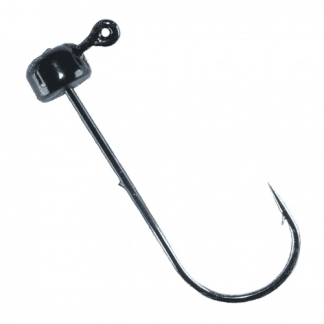
By Chad Hill
Castaic Pro Staff share their inside tips, tricks, and advice.

We have all heard the old saying attributed to Ralph Waldo Emerson, “build a better mousetrap, and the world will beat a path to your door.” Those very words ring loud and true in the sport of bass fishing. Every angler is constantly on the lookout for a better “bass trap”. Lure makers and component designers are more than happy to offer countless options from which to choose. Choices are virtually limitless, leading anglers to suffer from chronic indecision, standing in a tackle aisle for seemingly hours deciding among this, that, or the other.
Treble Hook Design
Let us take a step back and ask a question. What was/is the original “bass trap”? Easy answer: It is the fishing hook. Now, let’s narrow the focus to one particular type of widely used hook, the treble hook. All bass anglers are intimately familiar with the basic design of a treble hook. Three hook shanks emerge from just below the eye of the hook. Each extends downward a certain distance turning outward and bending back upward a shorter distance. A sharp point and a barb reside at the end of each short upward bend. We all know what that looks like, right?
As companies try to “build a better bass trap”, the design of the treble hook has undergone an evolution. The variations have become much more complex compared to the design I described in the previous paragraph. There are round bend hooks, short-shanked hooks, heavy wire hooks, “sure set” hooks, super line hooks, “triple grip” hooks, and EWG hooks. And, as one might expect, there are a myriad of rules and guidelines dedicated to deciding which treble hook style to deploy in each situation.
The “rule book” says to use round bend treble hooks when bass are slapping at a bait and not fully committing to it. The same book says to employ EWG treble hooks when the bass are engulfing a bait. Oh, and don’t forget to use short-shanked trebles to reduce the leverage a bass has to throw a bait by decreasing the distance between the hook bend and the bait itself.

KISS with Kitana Hooks
Is your head swimming like a ball of shad fleeing a school of five pounders as you sort through the countless scenarios referenced in the treble hook “rule book”?
For most bass chasers, both angling budgets and time on the water are limited at best. Therefore, decisions on and off the water must be efficient, maximizing the amount of benefit for the cost invested. Spending significant dollars to have every available design of treble hook at your disposal, then wasting time on the water changing styles of hooks on your crankbait after second-guessing your original hook choice is neither a description of angling efficiency nor a portrait of bass catching success. While acknowledging the validity of the application of some treble hook designs to maximize hookup and landing success in very specific situations and agreeing that some degree of an attention to detail is an asset of most successful bass anglers, my advice regarding treble hooks is to apply the KISS principle: Keep It Simple, Stupid.
Kitana Hooks is a company that applies this principle to its treble hook design. It stakes its reputation on a tried-and-true round bend treble hook. Kitana round bend treble hooks are strong, durable, and chemically sharpened. The hook shank is the correct length. The characteristics of a Kitana treble fit together perfectly. When a bass bites, Kitana round bend trebles “bite” back!
There is no doubt that the original round bend style of treble hook is the way to go on all lipped and lipless crankbaits, as well as topwater baits. It is acknowledged throughout the industry that the round bend is the best choice for situations when bass are not completely eating a bait.
So, why would a round bend treble hook be any less effective when bass are completely engulfing a bait? The answer is round bends are also just as effective in those situations. It makes the most sense to deploy the treble hook design that shines brightest when bass bites are less than aggressive. If an angler has that situation covered, other situations will take care of themselves. Let’s face it: There are more tough days on the water than easy ones. I want to use the treble hook design that is going to “trap ‘em” on those tough days so I can maximize my limited hours on the water, making casts instead of sitting on the deck of the boat changing treble hooks on my crankbaits.
-
Kitana Ned Rig Hook$7.99
Why Choose a Round Bend Treble Hook?
Why use the round bend over all others? There are three reasons to make this choice.
First, as alluded to previously, the round bend treble hook is acknowledged as the best hook for a finicky bass bite. I want the hook that is going to stick ‘em when they just get near it!
Second, the round bend design has a bigger “bite” to it. There are two contributing factors to the increased “hook bite”. The round bend design boasts a wider gap between the hook shank and the point. Also, it features more distance between the hook point and bottom of the bend. Increasing both the horizontal and vertical distance of the hook point from the shank as well as the bend increases the chance that the hook is going to stick and penetrate a bass’ mouth from the inside or gill plate area from the outside.
Think of it this way: The Kitana round bend treble hook has a bigger “mouth to bite with” when compared to other treble hook designs. For example, the point of an EWG style treble hook is bent back toward the hook shank. This design narrows the gap between the point and the shank, in effect “closing the mouth” of the hook. This narrower gap results in fewer solid hookups that often end with a four-pounder shaking free of a topwater walking bait despite your best effort to keep it under control.
And third, but just as important, the round bend treble is a design that has stood the test of time. It has put bass of all sizes in boats all over the world for decades. New product designs are not always better. The round bend treble hook is a prime example of the old adage, “if it ain’t broke, don’t fix it”.
While there are other characteristics of a treble hook to consider, such as wire thickness and shank length, the design of the hook bend is most critical. Rather than choosing a “trendy” design or one that is situation-specific, choose the treble hook design that performs in all situations: the round bend.
Among round bend treble hooks, Kitana is the “sharpest” choice. Kitana won’t distract an angler like a multitude of treble hook designs. Instead, Kitana will help you “keep it simple, stupid” and spend more time catching bass.





